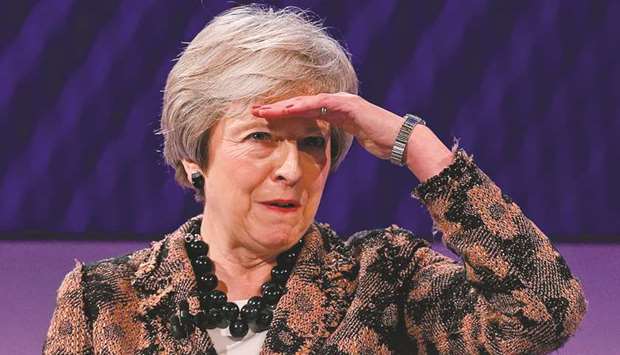The draft Brexit agreement will be rubber-stamped by a special European council meeting this weekend. But the current deal has little chance of making it through the Commons. Without parliamentary approval there is no path to a negotiated UK-EU agreement. Yet, so far, neither the UK nor EU has a proper plan B, other than a messy no deal. Time is running out to make changes to the deal to help it pass parliament.
A series of EU figures have been wheeled out to claim this deal is the final offer. They say they won’t change anything. But if that’s actually the case, there’s a serious danger things will go wrong. Because I’ve heard from three former Conservative chief whips, all of whom argue that this deal will not now pass parliament. Even Labour Brexit-backers threaten to vote against it.
Of course, it’s not going to be possible to tear up everything and start again. It’s taken over a year and a half of snail-like negotiations to get here. And it’s hard to see the EU offering Theresa May an agreement without a backstop at this stage, even if she demands they drop it. Equally, calls to accept the EU’s supposed offer of a Canada-style trade deal miss the point that such an agreement is only on offer via a backstop.
However, the overarching goal of Michel Barnier and his team is a deal. This draft agreement is far from ideal for the UK. But it’s also true that British negotiators won important concessions precisely because Brussels is keen to reach agreement. The EU climbed down on various points, from the size of Britain’s financial contribution, to governance of the withdrawal agreement, and from a UK-wide customs union, to the backstop itself. Although problematic and undesirable for the UK, the backstop is nonetheless an example of a bespoke relationship with neither free movement of people nor significant membership contributions – exactly what the EU pretended was not on offer.
When the prime minister meets EU leaders she should level with them and admit that the domestic reaction to the deal has been worse than she expected. At cabinet last week, her chief whip told ministers the DUP would abstain and predicted the deal would pass the Commons. That no longer seems plausible at this point, with dozens of Conservatives lined up to vote it down. So Theresa May should tell the assembled dignitaries that the deal is a dead duck, unless there can be limited but substantive changes to the withdrawal agreement and a significant development of the political declaration.
The political declaration, which was published alongside the draft withdrawal treaty, was almost painfully thin. Rather than giving confidence, it exacerbated concerns about the backstop by revealing that agreement about our future was so inchoate. Crucially, a revised text should set out a choice of future relationships: either a looser economic model closer to that of Canada’s free trade agreement with technological solutions on the Irish border, or a more integrated agreement based on “deep” regulatory co-operation, as well as perhaps ultimately an even closer relationship designed to meet Labour’s concerns. One line in the current draft helped trigger the resignation of former Brexit secretary Dominic Raab. The commitment that the “customs arrangements” will “build on the [backstop’s] single customs territory” was added at the last minute. It should be removed, or explicitly refer to just the path towards a more integrated relationship.
Next the prime minister needs to agree three key changes to the divorce text – the withdrawal agreement. First, a “lock” for the Northern Ireland executive and assembly, the institutions of the 1998 Good Friday/Belfast agreement. Back in December, both the UK and EU agreed a joint report that said that there would be “no new regulatory barriers” between Northern Ireland and Great Britain unless the “executive and assembly agree … distinct arrangements are appropriate”. That lock should be reintroduced, to help address DUP concerns about the backstop.
Second, hidden within an annex is an article that some interpret as allowing the EU to levy tariffs on goods moving from the UK to Northern Ireland or the EU. All UK political parties have ruled out a customs border down the Irish Sea. So this article should be amended explicitly to prevent the EU unilaterally imposing such a customs border within the UK.
Third, the UK has been unable to secure a workable unilateral exit mechanism from the backstop, despite Raab’s best efforts. This failure has exacerbated concerns that the UK could be “trapped” in the backstop. One way to break the impasse could be to state that the backstop does not create a permanent relationship, yet applies “as long as” the EU was working “to negotiate and conclude” a permanent agreement with the UK. This would be a fudge but would give both sides some surety.
EU leaders will be loath to reopen the deal. But if they refuse they need to think carefully about the consequences. The drama of a potential leadership challenge, as well as Labour’s desire to play political games, underscore the weakness of May’s domestic political position. By the time the deal is rejected by parliament at its first vote, her space for manoeuvre may be even less. There’s no point securing a deal that works perfectly in Brussels theory, but doesn’t survive contact with Westminster politics – after all, that would be to repeat the mistakes of David Cameron’s renegotiation.
*Henry Newman is the director of Open Europe. He has worked in the Cabinet Office and Ministry of Justice.

Britain’s Prime Minister Theresa May gestures as she takes a question after speaking at the annual Confederation of British Industry (CBI) conference in central London, on Monday. British Prime Minister Theresa May on Monday defended her draft Brexit deal to business leaders ahead of u201cintense negotiationsu201d with Brussels in the coming week.
